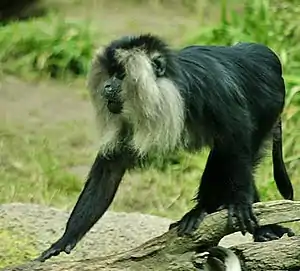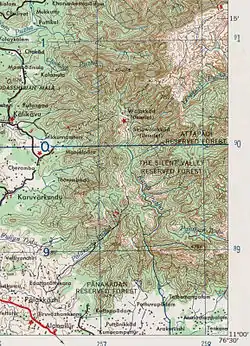Save Silent Valley
Save Silent Valley was a social movement aimed at the protection of Silent Valley, an evergreen tropical forest in the Palakkad district of Kerala, India. It was started in 1973 by an NGO led by school teachers and the Kerala Sastra Sahithya Parishad(KSSP) to save the Silent Valley from being flooded by a hydroelectric project. The valley was declared as Silent Valley National Park in 1985. The Kuntipuzha is a major river that flows 15 oelectric dam across the Kunthipuzha River that runs through Silent Valley, that will submerge 8.3 sq km of untouched moist evergreen forest. In February 1973, the Planning Commission approved the project at a cost of about Rs 25 crores.

After the announcement of imminent dam construction the valley became the focal point of Save Silent Valley Movement, India's fiercest environmental debate of the decade. Because of concern about the endangered lion-tailed macaque, the issue was brought to public attention. Romulus Whitaker, founder of the Madras Snake Park and the Madras Crocodile Bank, was probably the first person to draw public attention to the small and remote area.[1] In 1977 the Kerala Forest Research Institute carried out an ecological impact study of the Silent Valley area and proposed that the area be declared a biosphere reserve. In 1978 Indira Gandhi, Prime Minister of India, approved the project, with the condition that the state government enact legislation ensuring the necessary safeguards. Also that year the IUCN (International Union of conservation of nature) passed a resolution recommending protection of lion-tailed macaques in Silent Valley and Kalakkad and the controversy heated up. In 1979 the Government of Kerala passed legislation regarding the Silent Valley Protection Area (Protection of Ecological balance Act of 1979) and issued a notification declaring the exclusion of the hydroelectric project area from the proposed national park.
Participants
Kerala Sasthra Sahithya Parishad (KSSP) effectively aroused public opinion on the requirement to save Silent Valley. They also published a techno-economic and socio-political assessment report on the Silent Valley hydroelectric project. The poet activist Sugathakumari played an important role in the Silent Valley protest and her poem "Marathinu Stuthi" ("Ode to a Tree:) became a symbol for the protest from the intellectual community and was the opening song/prayer of most of the "save the Silent Valley" campaign meetings.[2] Dr. Salim Ali, eminent ornithologist of the Bombay Natural History Society, visited the valley and appealed for cancellation of the hydroelectric project.[3] A petition of writ was filed before the High Court of Kerala, against the clear cutting of forests in the hydroelectric project area and the court ordered a stop to the clear cutting.
Dr. M.S. Swaminathan, the renowned agricultural scientist, and then secretary to the Department of Agriculture, called at the Silent Valley region and his suggestion was 389.52 km2 including the Silent Valley (89.52 km2), New Amarambalam (80 km2), Attappadi (120 km2) in Kerala and Kunda in Tamil Nadu (100 km2) reserve forests, should be made into a national rainforest biosphere reserve, with the aim of "preventing erosion of valuable genes from the area".[4]Listen:(8:46) to Dr. M. S. Swaminathan speaking on Sustainable Development, p.83, August 27, 2002
In January 1980 the High Court of Kerala lifted the ban on clear cutting, but then the Prime Minister of India requested the Government of Kerala to stop further works in the project area until all aspects were fully discussed. In December, the Government of Kerala declared the Silent Valley area, excluding the hydroelectric project area, as a national park.
In 1982, a multidisciplinary committee with Prof. M. G. K. Menon as chairman and Madhav Gadgil, Dilip K. Biswas and others as members, was created to decide if the hydroelectric project was feasible without any significant ecological damage.[5] Early in 1983, Prof. Menon's Committee submitted its report. After a careful study of the Menon report, the Prime Minister of India decided to abandon the Project. On 31 October 1984 Indira Gandhi was assassinated and on 15 November the Silent Valley forests were declared as a national park, though the boundaries of the Silent Valley Park were limited and no buffer zone was created, despite recommendations by expert committees and scientists.[6]
Park inaugurated

Topography 1:250,000., 1959
Ten years later, on 7 September 1985 the Silent Valley National Park was formally inaugurated and a memorial at Sairandhri to Indira Gandhi was unveiled by Rajiv Gandhi, the new Prime Minister of India. On 1 September 1986 Silent Valley National Park was designated as the core area of the Nilgiri Biosphere Reserve.
Since then, a long-term conservation effort has been undertaken to preserve the Silent Valley ecosystem.[7]
In 2001 a new hydro project was proposed and the "man vs. monkey debate" was revived. The proposed site of the dam (64.5 m high and 275 m long) is just 3.5 km downstream of the old dam site at Sairandhiri, 500 m outside the national park boundary.[8] The 84 km2 catchment of the project area included 79 km2 of the Silent Valley National Par
T New whispers</ref> However, The spectacular waterfall between the Neelikkal and Pathrakkadavu hills bordering the Silent Valley will disappear if the proposed Pathrakkadavu hydro-electric project is implemented.[9] - Image
During January to May 2003 a rapid Environmental Impact Assessment (EIA) was carried out during by the Thiruvananthapuram-based Environmental Resources Research Centre and its report was released in December, stating that forest lost due to the project would be just .2216 km2, not including the 7.4 km approach road and land to be acquired for the powerhouse in Karapadam.
Present status
- Little more was heard till 15 November 2006 when Kerala Minister for Forest Binoy Viswam said that the proposed buffer zone for Silent Valley would be declared soon.[10]
- On 21 February 2007 Chief Minister A. K. Antony told reporters after a cabinet meeting that "when the Silent Valley proposal was dropped, the centre had promised to give clearance to the Pooyamkutty project. This promise, however, had not been honoured. The Kerala government has not taken any decision on reviving the Silent Valley Hydel Project".[11]
- On 22 March 2007 the activist poet Sugathakumari appealed to the Chief Minister of Kerala to restrain the Electricity Minister from reviving the proposal for a hydroelectric project at Pathrakkadavu.[12]
- On 18 April 2007, Kerala Chief Minister V S Achuthanandan and his cabinet approved the Pathrakkadavu Hydro-electric project and sent it to the Union Government for environmental approval.,[13][14]
- The 147.22 km2 Silent Valley Buffer Zone was formally approved by the Kerala Cabinet on June 6, 2007. The cabinet also sanctioned 35 staff to protect the area and two new forest stations in Bhavani range at Anavai and Thudukki. The zone is aimed at checking the illicit cultivation of ganja, poaching and illicit brewing in areas adjacent to Silent Valley and help long-term sustainability of the protected area.[15]
Movie
Only An Axe Away is a well-researched film documentary on the struggle to preserve the Silent Valley. The film shares the anxiety of the people of Kerala about the future of the Silent Valley. Producer: Third Eye Communications, Director: P. Baburaj and C.Saratchandran 2003/40min/2004/DV.[16] http://www.blip.tv/file/2286571/
References
- Ministry of Environment and Forests, ic/wssd/doc.3, Chapter 18, "Storm over Silent Valley, A Peoples Movement Saves A Valley" A Peoples Movement
- Sridevi Mohan (April 24, 2004). "Bio-reserve nonpareil". The Hindu. Retrieved May 5, 2014.
- Ministry of Environment and Forests, (India) and Centre for Environment Education(2002) "Storm over Silent Valley - A People’s movement saves a rainforest", Towards Sustainability: Learning from the Past, Innovating for the Future, U.N. World Summit on Sustainable Development, retrieved 3 March 2007 Storm over Silent Valley
- Surendranath C, "Silent Valley: threatened again", India Together, 13 Feb 2007 Threatened again
- Prasad (2008). Environment, Development and Society in Contemporary India:An Introduction. Macmillan. p. 438. ISBN 9780230635302.
- Philip, Shaju (1 November 2009). "A Silent Revolution". The Indian Express Limited. Archived from the original on 20 November 2009. Retrieved 3 February 2021.
- Gledhill,Laurence, AZA SSP Coordinator, Lion-tailed macaques, Woodland Park Zoological Gardens, 5500 Phinney Ave. N., Seattle, WA 98103, "Silent Valley - A Masterplan for The Indian Ex-situ Population of Lion-tailed Macaques, Macaca silenus" and "A Historical Profile of Habitat Conservation in Kerala, India", Newsletter for the Old World Monkey Taxon Advisory Group, American Zoo and Aquarium Association, Volume 3, Number 2, Winter 1996.A Historical Profile
- Kumar, K.G.,"Silent Valley redux?" Financial Daily from The HINDU, Monday, May 24, 2004 Silent Valley redux?
- Mustafah K.K. (Jun 30, 2004) "Vanishing fall?", Financial Daily from THE HINDU group, Front Page, retrieved 3/25/2007 "Vanishing fall?"
- The Hindu, Nov. 17 Kerala minister of Forests: "Proposed buffer Zone to be declared soon. "Proposed buffer Zone
- Times of India, "No decision yet on Silent Valley: Antony" Feb. 23.No decision yet
- The Hindu, "Draft policy moots survey of State's forest area and its demarcation",(Mar 22, 2007) Front Page, retrieved 3/25/2007 policy moots survey
- Newindpress.com (April 19, 2007) "Green Marxist succumbs to ‘Power’ needs" retrieved 5/10/2007 ,"Green Marxist succumbs to ‘Power’ needs" Archived 2007-09-27 at the Wayback Machine
- SUCHITRA M (June 12, 2007) Kerala clears Pathrakkadavu hydroelectric project near national park, Down to Earth, retrieved 6/12/2007 Kerala clears Pathrakkadavu hydroelectric project Archived 2007-09-28 at the Wayback Machine
- June 6, 2007, Cabinet approves buffer zone for Silent Valley, The Hindu, Front page, retrieved June 8, 2007
- SANKAR, ANAND, The Hindu, "Not silent anymore", 6/2/2006.film documentary